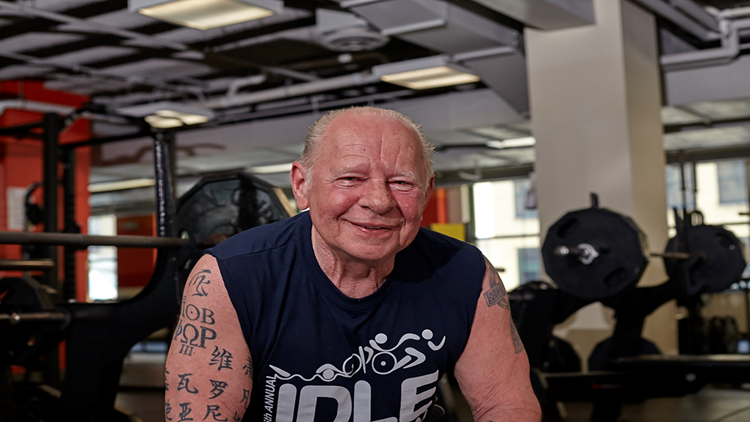Denver, CO — By Sandra Crews, Health Strategist, UnitedHealthcare of Colorado
When Patrick Mulqueen retired in 2011 at the age of 62, he found that his more relaxed schedule came with an unwelcome side effect that’s all too familiar to retirees: weight gain. No longer walking daily for his outdoor sales job, he began packing on the pounds.
“I fell into a common trap. I was no longer active and didn’t change my eating habits,” Mulqueen said.
Determined to fight back against the creeping numbers on the scale, Mulqueen found a lifeline by joining a fitness program tailored for seniors at the YMCA in his neighborhood, a benefit available through his UnitedHealthcare Medicare Advantage plan. Little did he know that the two-day-a-week program would lead to much more than a trimmer waistline.
With the help of a wellness instructor, he added a strength training program into his routine and became a regular in the weight room. Within two years, he shed 70 pounds, gained a great deal of muscle mass and cut down on his body fat, reversing the effects of age-related muscle loss.
“Feeling strong just makes it a whole lot easier to get around in the world,” Mulqueen, now 70, said. “I don’t have any trouble walking up steps or carrying groceries. I feel like I’m an 18-year-old kid again.”
As we grow older, keeping up our strength is essential to maintaining health and the ability to live independently. Starting as early as our 30s, we begin to experience sarcopenia, the natural loss of muscle mass and strength that occurs with age. Overall, we lose about 35 to 40 percent of our muscle mass between the ages of 20 and 80.
But according to experts, by adding a strength training regimen into their fitness routine, seniors can help minimize the effects of age-related muscle loss.
Despite the benefits of strength training, it’s not uncommon for people to focus mainly on cardio activities. It can be tempting to dedicate all of our exercise time to burning calories in an effort to stave off weight gain, and for some, picking up a set of weights for the first time can be intimidating. Whatever the reason, strength training is often overlooked.
“It’s so critical. Resistance training protects muscle mass and joint integrity while also helping maintain bone density,” said Cliff Edberg, national program manager for personal training and nutrition coaching at Life Time, a national chain of health and fitness centers. “There’s a strong correlation between muscle mass and longevity in older adults.”
According to the U.S. Centers for Disease Control and Prevention, strength training helps reduce the symptoms of many chronic diseases and conditions that commonly afflict older adults, including arthritis, diabetes, osteoporosis, heart disease, obesity and back pain. Studies show that strength training may also help reduce depression and boost confidence and self-esteem.
Edberg, who works with many older adults on strength training, notices some common issues among this age group. Many who’ve spent decades working sedentary jobs in an office setting have poor posture, weak glutes and tight hip flexors. He has his clients focus on mobility and strengthening the posterior chain, the essential group of muscles that includes the glutes, hamstrings and lower back.
He also ensures that his older clients do at least 10 minutes of warm-up before starting any strength work. “As you age, it takes additional time to prepare the body for movement, especially movement that is explosive or with resistance,” he said.
For Mulqueen, adding strength training to his fitness routine has transformed his life. As he gained confidence in his weight-lifting abilities, he decided to take his fitness commitment to the next level by entering his local Senior Olympics power lifting competition, winning a medal his first year. In subsequent years, he added track and field events, bringing home the gold medal in the shot put. Today he serves on his Senior Olympics board and enjoys being a role model for his peers.
“I really need to get my message out. It’s just so important for us seniors. If you don’t use those muscles, you just lose them,” he said.
Tips on Getting Started with Strength Training
- As a first step, check with your health care provider before doing any strength training work. The last thing you want to do is injure yourself. Talking with your doctor about your fitness goals can help you understand any limitations you should be mindful of as well as how you can safely participate in strength training.
- Aim to incorporate strength training in your fitness routine at least two to three times a week, allowing days off for muscle recovery.
- Consider working with a professional fitness trainer who can do an initial strength and mobility assessment and help you develop a safe strength-training routine. Working under the guidance of a trainer can help you build up your confidence. Most gyms have personal trainers on staff, some who have expertise in working with senior clients.
- If you’re enrolled in a Medicare Advantage or Medicare supplement plan, check if your plan offers fitness benefits. Many plans include a gym membership for no additional cost or a discounted monthly fee. Most UnitedHealthcare Medicare Advantage members, for example, can take advantage of fitness benefits through SilverSneakers or Optum Fitness Advantage. You can learn more about UnitedHealthcare’s plans in your area at www.UHCMedicareSolutions.com.



